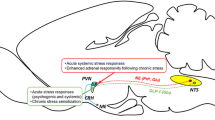Summary
As previously shown (Lynch et al.: Proc. Nat. Acad. Sci. [U.S.A.]70, 1704–1707 [1973]), the activity of the enzyme serotonin-N-acetyltransferase (NAT) in the rat pineal increases when the animal is placed in darkness or is subjected to the stress of physical immobilization; partial sympathetic denervation (i.e., pretreatment of the animal with intravenous 6-hydroxydopamine [6-OHDA]) does not block either response. The present studies explored the roles of the pineal sympathetic nerves and the adrenal medullas in mediating these responses. The stress-induced increase in pineal NAT activity was blocked by bilateral adrenalectomy, but not by bilateral superior cervical ganglionectomy or by treatment with 6-OHDA (both of which potentiate the NAT response in normal rats and restore it in adrenalectomized ones). The increase in pineal melatonin content caused by immobilization was also blocked by adrenalectomy, but potentiated by pineal sympathetic denervation. In contrast, bilateral adrenalectomy did not affect the darkness-induced rise in pineal NAT activity, although pineal sympathetic denervation (by bilateral superior cervical ganglionectomy) did block this response. 6-OHDA pretreatment neither blocked the response to darkness nor restored it in ganglionectomized animals; thus, this treatment apparently fails to produce a complete pineal denervation. The pineal response to stress has previously been shown to be blocked byβ-adrenergic blocking agents. The present studies demonstrate thatα-adrenergic blockade (with phenoxybenzamine) potentiates this response in intact animals and restores it in adrenalectomized rats (possibly by acting presynaptically on receptors on pineal sympathetic terminals and thereby augmenting norepinephrine release). These observations show that the rat pineal organ normally receives information from two “channels”,i.e., trans-synaptically (from pineal sympathetic nerves) and via the circulation (from the adrenal medullas and, perhaps, from distant sympathetic nerves).
Similar content being viewed by others
References
Axelrod, J., Wurtman, R. J., Snyder, S. H.: Control of hydroxyindole-O-methyltransferase activity in the rat pineal gland by environmental lighting. J. Biol. Chem.240, 949–954 (1965).
Axelrod, J., Shein, H., Wurtman, R. J.: Stimulation of14C-melatonin synthesis from14C-tryptophan by noradrenalin in rat pineal organ culture. Proc. Nat. Acad. Sci. (U.S.A.)62, 544–549 (1969).
Axelrod, J.: The pineal gland: A neurochemical transducer. Science184, 1341–1348 (1974).
Cardinali, D. P., Larin, F., Wurtman, R. J.: Action spectra for effects of light on hydroxyindole-O-methyltransferase in rat pineal, retina, and Harderian gland. Endocrinology91, 877–886 (1972).
Deguchi, T., Axelrod, J.: Induction and superinduction of serotonin N-acetyltransferase by adrenergic drugs and denervation in rat pineal organ. Proc. Nat. Acad. Sci. (U.S.A.)69, 2208–2211 (1972).
Enero, M. A., Langer, S. Z., Rothlin, R. P., Stefano, F. J. E.: Role of theα-adrenoceptor in regulating noradrenaline overflow by nerve stimulation. Brit. J. Pharmacol.44, 672–688 (1972).
Eränkö, O., Eränkö, L.: Loss of histochemically demonstrable catecholamines and acetylcholinesterase from sympathetic nerve fibres of the pineal body of the rat after chemical sympathectomy with 6-hydroxydopamine. Histochem. J.3, 357–363 (1971).
Kirpekar, S. M., Puig, M.: Effect of flow-stop on noradrenaline release from normal spleens and spleens treated with cocaine, phentolamine or phenoxybenzamine. Brit. J. Pharmacol.43, 359–369 (1971).
Klein, D. C., Weller, J. L.: Indole metabolism in the pineal gland: A circadian rhythm in N-acetyltransferase. Science169, 1093–1095 (1970).
Klein, D. C., Weller, J. L.: Adrenergic-adenosine 3′ 5′-monophosphate regulation of serotonin N-acetyltransferase activity to synthesis of3H-N-acetylserotonin and3H-melatonin in the cultured rat pineal gland. J. Pharmacol. Exp. Therap.189, 516–527 (1973).
Lynch, H. J.: Diurnal oscillations in pineal melatonin content. Life Sci.10, 791–795 (1971).
Lynch, H. J., Wang, P., Wurtman, R. J.: Increase in rat pineal melatonin content following L-dopa administration. Life Sci.12, 145–151 (1973 a).
Lynch, H. J., Eng, J. P., Wurtman, R. J.: Control of pineal indole biosynthesis by changes in sympathetic tone caused by factors other than environmental lighting. Proc. Nat. Acad. Sci. (U.S.A.)70, 1704–1707 (1973 b).
Lynch, H. J., Hsuan, M., Wurtman, R. J.: Sympathetic neural control of indoleamine metabolism in the rat pineal gland. In: Biological rhythms and endocrine function: Advances in experimental medicine and biology (Hedlund, L. W., Franz, J. M., Kenny, A., eds.), pp. 93–105. New York: Plenum Press. 1975.
Minneman, K. P., Lynch, H. J., Wurtman, R. J.: Relationship between environmental light intensity and retina-mediated suppression of rat pineal serotonin-N-acetyltransferase. Life Sci.15, 1791–1796 (1974).
Moore, R. Y., Heller, A., Wurtman, R. J., Axelrod, J.: Visual pathways mediating pineal response to environmental lighting. Science155, 220 to 223 (1967).
Nagle, C. A., Cardinali, D. P., Rosner, J. M.: Light regulation of rat retinal hydroxyindole-O-methyl transferase (HIOMT) activity. Endocrinology91, 423–426 (1972).
Quay, W. B.: Circadian rhythm in rat pineal serotonin and its modifications by estrous cycle and photoperiod. Gen. Comp. Endocrinol.3, 473–479 (1963).
Ralph, C. L., Lynch, H. J.: A quantitative melatonin bioassay. Gen. Comp. Endocrinol.15, 334–338 (1970).
Ralph, C. L., Mull, D., Lynch, H. J., Hedlund, L.: A melatonin rhythm persists in rat pineals in darkness. Endocrinology89, 1361–1366 (1971).
Shein, H. M., Wurtman, R. J.: Cyclic adenosine monophosphate: Stimulation of melatonin and serotonin synthesis in cultured rat pineals. Science766, 519–520 (1969).
Taylor, A. N., Wilson, R. W.: Electrophysiological evidence for the action of light on the pineal gland in the rat. Experientia26, 267–269 (1970).
Thoenen, H., Tranzer, J. P.: Chemical sympathectomy by selective destruction of adrenergic nerve endings with 6-hydroxydopamine. Arch. Exp. Pathol. Pharmacol261, 271–288 (1968).
Wennmalm, A.: Quantitative evaluation of release and reuptake of adrenergic transmitter in the rabbit heart. Acta Physiol. Scand.82, 532–538 (1971).
Wurtman, R. J., Axelrod, J., Phillips, L.: Melatonin synthesis in the pineal gland: Control by light. Science142, 1071–1073 (1963).
Wurtman, R. J., Axelrod, J., Fischer, J. E.: Melatonin synthesis in the pineal gland: Effect of light mediated by the sympathetic nervous system. Science143, 1328–1330 (1964).
Wurtman, R. J., Axelrod, J., Kelly, D. E.: The pineal. New York: Academic Press. 1968.
Wurtman, R. J., Shein, H. M., Larin, F.: Mediation byβ-adrenergic receptors of effect of norepinephrine on pineal synthesis of14C-serotonin and14C-melatonin. J. Neurochem.18, 1683–1687 (1971).
Author information
Authors and Affiliations
Rights and permissions
About this article
Cite this article
Lynch, H.J., Ho, M. & Wurtman, R.J. The adrenal medulla may mediate the increase in pineal melatonin synthesis induced by stress, but not that caused by exposure to darkness. J. Neural Transmission 40, 87–97 (1977). https://doi.org/10.1007/BF01250561
Received:
Issue Date:
DOI: https://doi.org/10.1007/BF01250561




